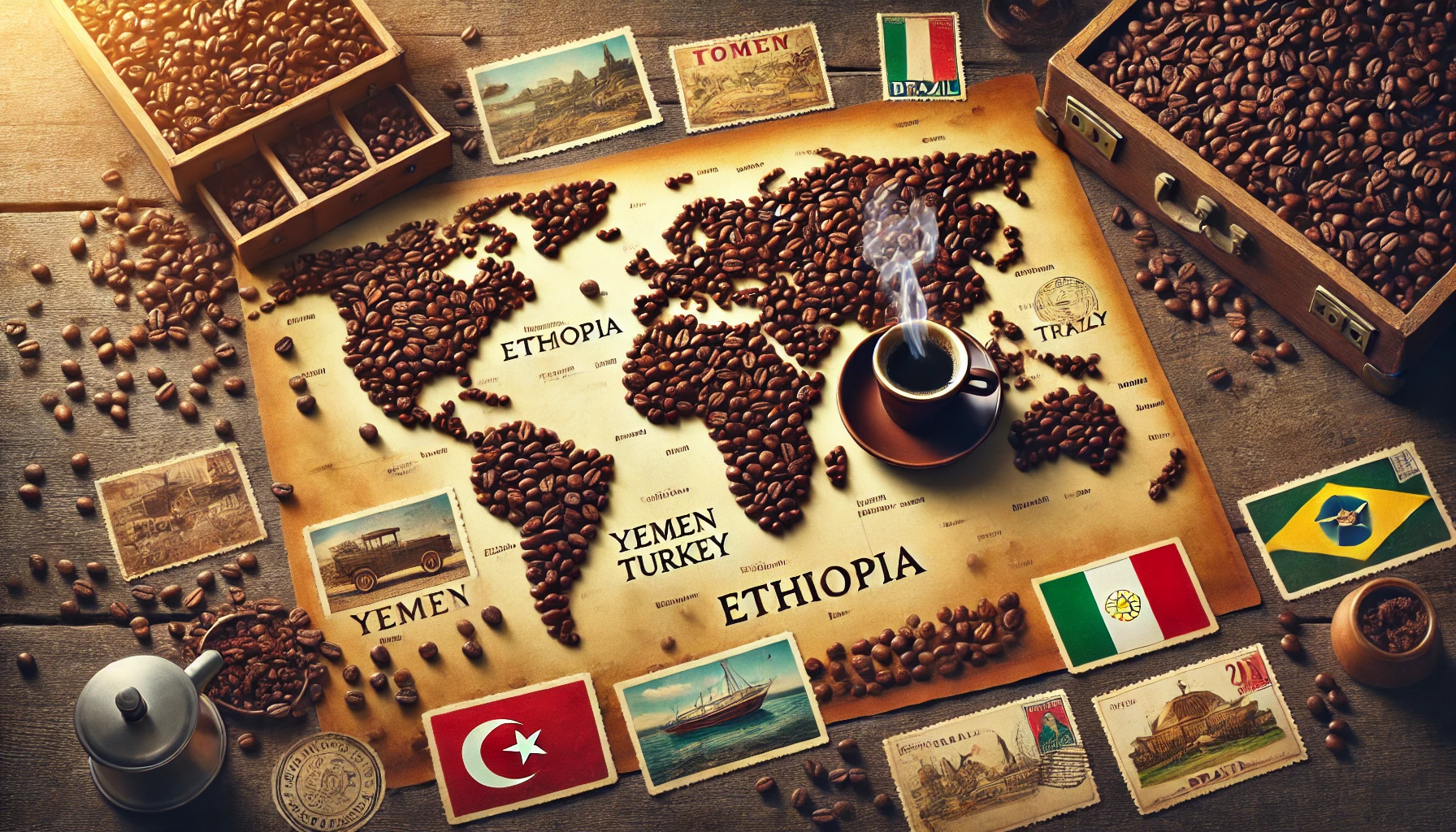Coffee is the world’s second most traded commodity, only behind oil. From ancient rituals to modern cafés, this beloved beverage has journeyed through continents, empires, revolutions, and centuries. Understanding how coffee conquered the world helps us appreciate each cup a little more.
The Birthplace of Coffee: Ethiopia
The story begins in the lush highlands of Ethiopia, where wild coffee plants still grow today. According to legend, a goat herder named Kaldi noticed his goats became unusually energetic after eating red berries from a shrub. Curious, he tried the berries himself and experienced the same burst of energy.
The local monks began brewing the berries into a drink to stay awake during long night prayers. This early form of coffee was born not as a casual drink but as a spiritual aid.
Coffee Crosses the Red Sea: Arrival in Yemen
By the 15th century, coffee cultivation and preparation had moved from Ethiopia to Yemen. The city of Mocha, located on the coast of the Red Sea, became the first major center of coffee trade. Sufi mystics in Yemen used coffee during their nightly meditations to stay alert, and word about this energizing brew began to spread.
Coffee was boiled in water, producing a drink known as qahwa, meaning “that which prevents sleep.” From Yemen, coffee began to travel with pilgrims and traders to other parts of the Arab world.
The First Coffeehouses: Culture Meets Caffeine
As coffee spread across Mecca, Medina, and Cairo, the first coffeehouses—called qahveh khaneh—emerged. These establishments were revolutionary. They weren’t just places to drink coffee; they became hubs of conversation, music, chess, poetry, and politics.
By the 16th century, coffeehouses were so influential that they were sometimes viewed as threats by rulers and religious leaders. Several attempts were made to ban coffee and close coffeehouses, but public demand always won.
Expansion into the Ottoman Empire
Coffee reached Constantinople (modern-day Istanbul) by 1555, where it was embraced as part of Ottoman elite culture. Specialized coffee makers known as kahveci usta prepared the beverage in the palace, and it became integral to courtly customs and marriage rituals.
The Ottomans elevated coffee preparation to an art form, creating elaborate brewing tools and serving customs that would influence future European coffee culture.
Coffee Reaches Europe: A Mixed Welcome
Coffee made its way to Venice by the early 1600s, thanks to trade routes between Europe and the Arab world. Initially, coffee was seen with suspicion—some clergy even labeled it “the bitter invention of Satan.”
However, public opinion changed when Pope Clement VIII allegedly tried coffee, enjoyed it, and gave it his approval. Coffee soon became wildly popular across Italy, and its influence spread rapidly throughout Europe.
Coffeehouses began popping up in London, Paris, Vienna, and Amsterdam. In England, they were called “penny universities” because for the price of a penny, one could gain access to conversation, news, and intellectual debate.
Colonialism and the Global Coffee Trade
European powers realized coffee’s potential as a cash crop and began cultivating it in their colonies. Here’s how different empires helped spread coffee:
- Dutch: Smuggled coffee plants out of Yemen and began large-scale plantations in Java, Indonesia.
- French: Planted coffee in the Caribbean (notably Martinique and Haiti).
- Portuguese: Took coffee to Brazil, which would become the world’s largest producer.
- Spanish: Introduced coffee cultivation to Central America.
Coffee was no longer a regional drink—it had become a global commodity.
The Rise of Coffee in the Americas
Coffee cultivation flourished in Latin America during the 18th and 19th centuries, with Brazil emerging as a powerhouse. By 1852, Brazil became the world’s largest coffee producer, a title it still holds today.
The growth of plantations, unfortunately, also tied coffee to colonialism and slave labor, especially in Brazil and the Caribbean. Understanding this history is key to making ethical choices today, as modern coffee consumers push for fair trade and sustainability.
Coffee and the Industrial Revolution
The 19th century brought major technological changes that influenced coffee production and consumption:
- Vacuum packaging extended coffee shelf life.
- Roasting machines improved consistency and allowed for mass production.
- Instant coffee emerged in the early 20th century, revolutionizing convenience.
- Coffee became a staple for factory workers and soldiers, fueling productivity and endurance.
In World War II, the U.S. military included instant coffee in soldiers’ rations, further boosting its popularity.
Modern Coffee Culture: From Global Chains to Artisanal Brews
By the late 20th century, coffee culture experienced a transformation. The rise of brands like Starbucks popularized espresso drinks and café experiences worldwide. Coffee was no longer just a drink—it became a lifestyle.
Simultaneously, a counter-movement known as the “third wave of coffee” began. This movement treats coffee as a craft product, focusing on:
- Transparency in sourcing
- Support for small farmers
- Manual brewing methods
- Flavor complexity and appreciation
Today, you’ll find coffeehouses that take as much pride in their beans and brewing techniques as high-end wineries.
Final Thoughts: A Bean That Shaped the World
From an energizing berry in Ethiopian hillsides to a global phenomenon found on every continent, coffee’s journey is remarkable. It’s shaped economies, ignited revolutions, inspired art, and connected people for centuries.
Whether you drink it for comfort, conversation, or caffeine, every cup of coffee is part of a story that began over a thousand years ago—and is still being written today.
